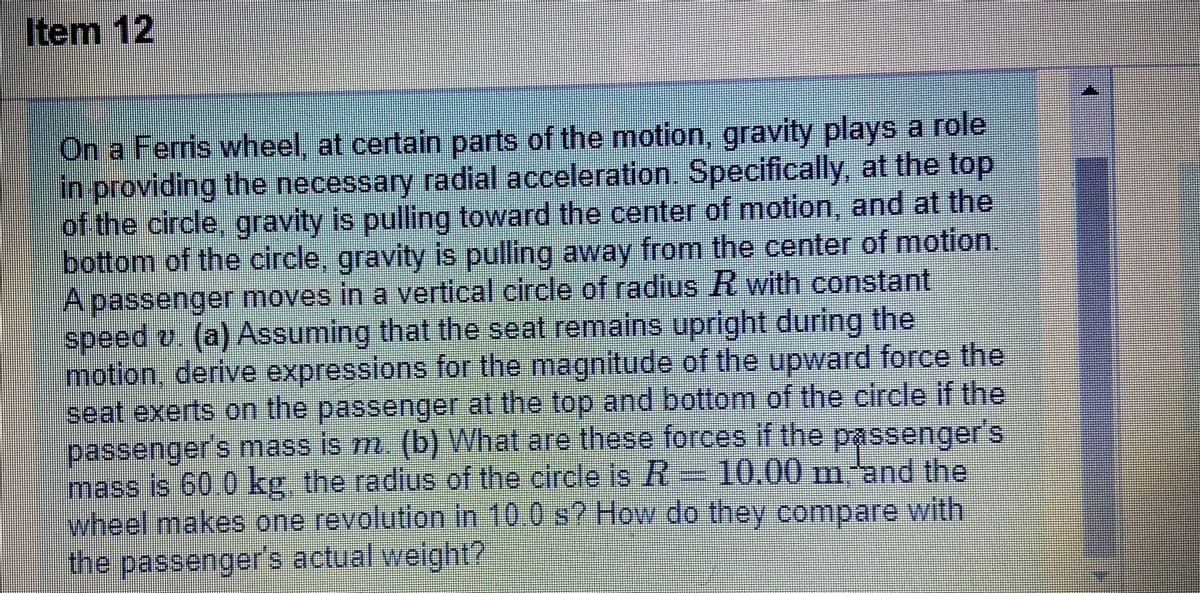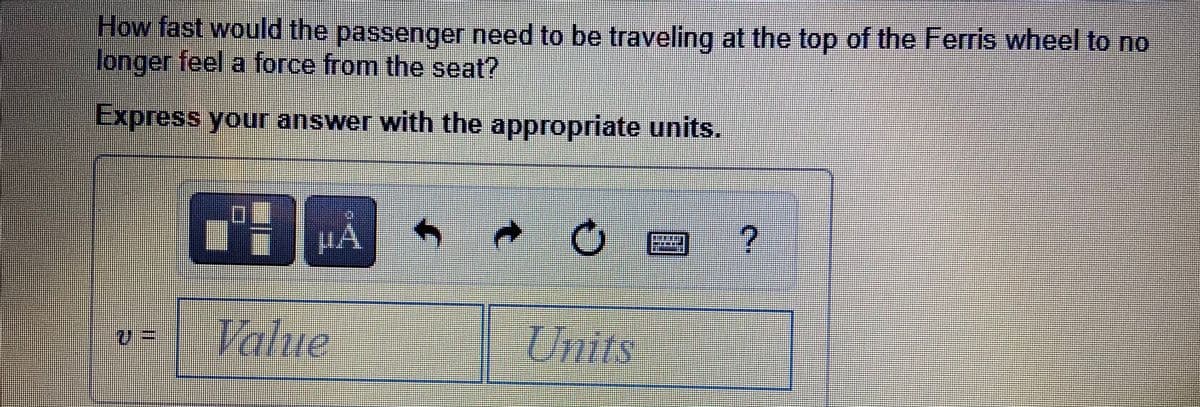On a Ferris wheel, at certain parts of the motion, gravity plays a role in providing the necessary radial acceleration. Specifically, at the top of the circle, gravity is pulling toward the center of motion, and at the bottom of the circle, gravity is pulling away from the center of motion. A passenger moves in a vertical circle of radius R with constant speed v. (a) Assuming that the seat remains upright during the motion, derive expressions for the magnitude of the upward force the seat exerts on the passenger at the top and bottom of the circle if the passenger's mass is m. (b) What are these forces if the passenger's mass is 60 0 kg, the radius of the circle is R wheel makes one revolution in 10.0 s? How do they compare with the passenger's actual weight? 10.00 m and the
On a Ferris wheel, at certain parts of the motion, gravity plays a role in providing the necessary radial acceleration. Specifically, at the top of the circle, gravity is pulling toward the center of motion, and at the bottom of the circle, gravity is pulling away from the center of motion. A passenger moves in a vertical circle of radius R with constant speed v. (a) Assuming that the seat remains upright during the motion, derive expressions for the magnitude of the upward force the seat exerts on the passenger at the top and bottom of the circle if the passenger's mass is m. (b) What are these forces if the passenger's mass is 60 0 kg, the radius of the circle is R wheel makes one revolution in 10.0 s? How do they compare with the passenger's actual weight? 10.00 m and the
Principles of Physics: A Calculus-Based Text
5th Edition
ISBN:9781133104261
Author:Raymond A. Serway, John W. Jewett
Publisher:Raymond A. Serway, John W. Jewett
Chapter3: Motion In Two Dimensions
Section: Chapter Questions
Problem 25P: As their booster rockets separate, Space Shuttle astronauts typically feel accelerations up to 3g,...
Related questions
Concept explainers
Topic Video
Question

Transcribed Image Text:Item 12
On a Ferris wheel, at certain parts of the motion, gravity plays a role
in providing the necessary radial acceleration. Specifically, at the top
of the circle, gravity is pulling toward the center of motion, and at the
bottom of the circle, gravity is pulling away from the center of motion.
A passenger moves in a vertical circle of radius R with constant
speed 2. (a) Assuming that the seat remains upright during the
motion, derive expressions for the magnitude of the upward force the
seat exerts on the passenger at the top and bottom of the circle if the
passenger's mass is m. (b) What are these forces if the passenger's
mass is 60.0 kg. the radius of the circle is R 10.00 m'and the
wheel makes one revolution in 10.0 s? How do they compare with
the passenger's actual weight?

Transcribed Image Text:How fast would the passenger need to be traveling at the top of the Ferris wheel to no
longer feel a force from the seat?
Express your answer with the appropriate units.
Value
Units
Expert Solution
This question has been solved!
Explore an expertly crafted, step-by-step solution for a thorough understanding of key concepts.
This is a popular solution!
Trending now
This is a popular solution!
Step by step
Solved in 2 steps with 2 images

Knowledge Booster
Learn more about
Need a deep-dive on the concept behind this application? Look no further. Learn more about this topic, physics and related others by exploring similar questions and additional content below.Recommended textbooks for you

Principles of Physics: A Calculus-Based Text
Physics
ISBN:
9781133104261
Author:
Raymond A. Serway, John W. Jewett
Publisher:
Cengage Learning

Physics for Scientists and Engineers: Foundations…
Physics
ISBN:
9781133939146
Author:
Katz, Debora M.
Publisher:
Cengage Learning

Principles of Physics: A Calculus-Based Text
Physics
ISBN:
9781133104261
Author:
Raymond A. Serway, John W. Jewett
Publisher:
Cengage Learning

Physics for Scientists and Engineers: Foundations…
Physics
ISBN:
9781133939146
Author:
Katz, Debora M.
Publisher:
Cengage Learning